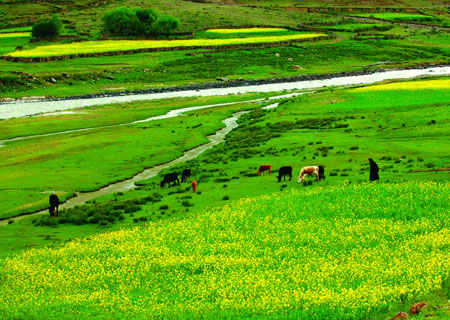| Tibet serves as the ecological safety barrier to China and even Asia, with a unique ecological zone. Strengthening ecological environment protection and construction, building the state ecological safety barrier on Tibet Plateau, keeping the ecological function, guaranteeing ecological safety and constructing the ecological Tibet have been the important content of steady ecological development.

The Northern Tibet Grassland cut through by the Qinghai-Tibet Railway is full of life. The railway is built with high attention paid to environmental protection.
In recent years, Tibet has specially set up a leading group for the Plan for the State Ecology Safety Barrier Protection and Construction on the Tibetan Plateau and invited the academicians and experts from the Chinese Academy of Science, State Commission of Natural Science Foundation and the China Meteorological Administration to come to Tibet for on-spot investigation. At present, this plan, with estimated investment totaling 38.7 billion Yuan, was due to be launched before the end of 2007. The construction and implementation of the plan will effectively check the degenerating trend of ecological systems around the headwaters of rivers and the key lakes in Tibet, maintain ecological functions on the Tibet Plateau such as water source conservation, biodiversity protection and the conservation of soil and water, enhance the capability for sustainable development of the regional economy and ensure the regional ecological safety and the nation's safety.
In order to realize this goal, Tibet will lay stress on strengthening the supervision and management of the ecological environment in developing important natural resources and tourist resources. Under the precondition of giving priority to protecting the ecological environment, it is actively exploring water and electricity resources in an orderly way, develop renewable energy resources such as the solar energy and geothermal energy and new energy resources such as biomass energy according to local conditions. It is standardizing the order of mineral resources development, adhering to the principle of "placing equal stress on protection and development" and promoting sustainable use of resources through protection. In conducting urban planning and construction, attention should be paid to the natural and ecological conditions, and the natural heritage, such as natural forest and grassland, rivers and lakes, shallows-tidal flat areas, wetlands, natural physiognomy and wild animals and plants, should be conserved as much as possible. Thus all these will promote the improvement of Tibet's ecological environment in an all-round way, providing a good ecological basis for its economic and social development. |





